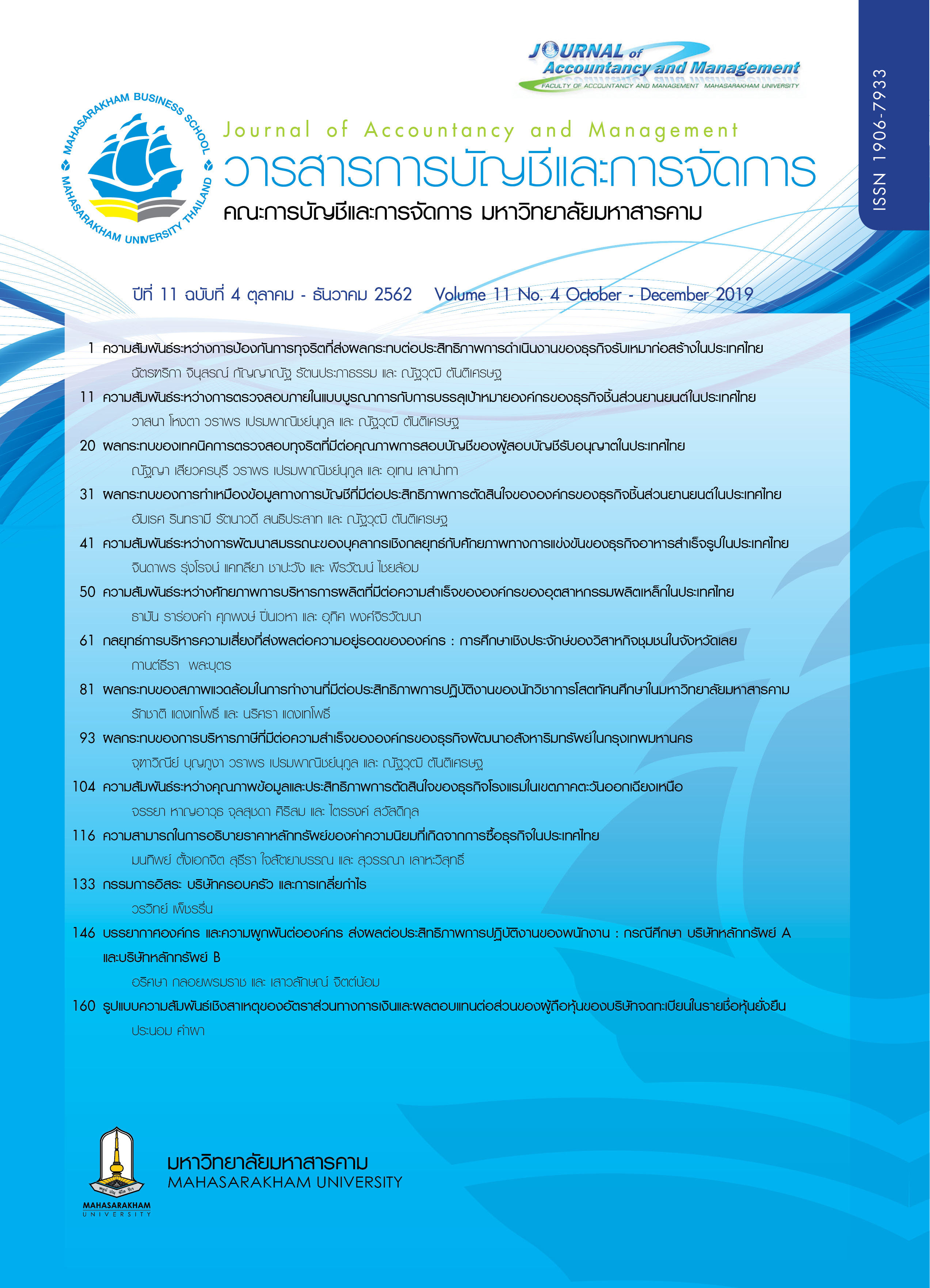รูปแบบความสัมพันธ์เชิงสาเหตุของอัตราส่วนทางการเงินและผลตอบแทนต่อส่วนของผู้ถือหุ้นของบริษัทจดทะเบียนในรายชื่อหุ้นยั่งยืน
Main Article Content
บทคัดย่อ
การวิจัยนี้มีวัตถุประสงค์เพื่อวิเคราะห์ความสัมพันธ์เชิงสาเหตุของอัตราส่วนทางการเงินและผลตอบแทนของผู้ถือหุ้น โดยศึกษาข้อมูลจากแบบแสดงรายการข้อมูลประจำปีของบริษัทจดทะเบียนในรายชื่อหุ้นยั่งยืน สำหรับ ปี พ.ศ. 2556 - 2560 จำนวน 57 บริษัท ผลการวิจัยอธิบายได้ว่า อัตราส่วนเงินทุนหมุนเวียนส่งอิทธิพลทางตรงเชิงลบ ต่ออัตราผลตอบแทนต่อส่วนของผู้ถือหุ้น ขณะที่อัตราส่วนหนี้สินต่อส่วนของผู้ถือหุ้น อัตรากำไรสุทธิและอัตราผลตอบแทนต่อสินทรัพย์ส่งอิทธิพลทางตรงเชิงบวกต่ออัตราผลตอบแทนต่อส่วนของผู้ถือหุ้น นอกจากนี้พบว่าอัตราส่วนเงินทุนหมุนเร็วส่งอิทธิพลทางอ้อมเชิงลบต่ออัตราผลตอบแทนต่อส่วนของผู้ถือหุ้นผ่านอัตราส่วนหนี้สิน ต่อส่วนของผู้ถือหุ้น อัตรากำไรสุทธิและอัตราผลตอบแทนต่อสินทรัพย์ โดยรูปแบบความสัมพันธ์ที่พัฒนาขึ้นมีความสอดคล้องกับข้อมูลเชิงประจักษ์ ที่ค่าสถิติ c2= 4.598, df = 7, c2/df = .657, P = .709, GFI = .972, AGFI = .916, RMSEA = .000, CFI = 1.000 ตลอดจนมีความสามารถในการพยากรณ์ได้ร้อยละ 91
Downloads
Article Details
บทความที่ได้รับการตีพิมพ์เป็นลิขสิทธิ์ของวารสารการบัญชีและการจัดการ
ข้อความที่ปรากฏในบทความแต่ละเรื่องในวารสารวิชาการเล่มนี้เป็นความคิดเห็นส่วนตัวของผู้เขียนแต่ละท่านไม่เกี่ยวข้องกับมหาวิทยาลัยมหาสารคาม และคณาจารย์ท่านอื่นๆในมหาวิทยาลัยฯ แต่อย่างใด ความรับผิดชอบองค์ประกอบทั้งหมดของบทความแต่ละเรื่องเป็นของผู้เขียนแต่ละท่าน หากมีความผิดพลาดใดๆ ผู้เขียนแต่ละท่านจะรับผิดชอบบทความของตนเองแต่ผู้เดียว
เอกสารอ้างอิง
กัลยา วานิชย์บัญชา. (2556). การวิเคราะห์สมการโครงสร้าง (SEM) ด้วย AMOS. กรุงเทพฯ : สามลดา.
ขวัญนภา เศิกศิริ, สมใจ บุญหมื่นไวย และธนภณ วิมูลอาจ. (2561). อิทธิพลของอัตราส่วนทางการเงินต่อราคาหลักทรัพย์ของบริษัทจดทะเบียนในตลาดหลักทรัพย์แห่งประเทศไทย : กรณีศึกษากลุ่มอุตสาหกรรมบริการ. วารสารชุมชนวิจัย, 12(2), 71-84.
ตลาดหลักทรัพย์แห่งประเทศไทย. (2560). แบบแสดงรายการข้อมูลประจำปี (แบบ 56-1). ค้นเมื่อ 20 มกราคม 2562,
ตลาดหลักทรัพย์แห่งประเทศไทย. (2561). รายชื่อหุ้นยั่งยืน ประจำปี 2561. ค้นเมื่อ 15 มกราคม 2562,
จาก https://lib.swu.ac.th/images/ guides/l19% 20how%20to%20citation% 20for%20web0614.pdf
ตลาดหลักทรัพย์แห่งประเทศไทย.. (2561). Thailand Sustainability Investment. ค้นเมื่อ 20 มกราคม 2562,
จาก https://www.set.or.th/ sustainable_dev/th/sr/sri/ thsi_p1.html
เพชรี ขุมทรัพย์. (2554). วิเคราะห์งบการเงิน: หลักและการประยุกต์. พิมพ์ครั้งที่ 12. กรุงเทพฯ : โรงพิมพ์มหาวิทยาลัยธรรมศาสตร์.
เยาวนุช รักสงฆ์. (2562). ผลกระทบของประสิทธิภาพระบบสารสนเทศทางการบัญชีต่อผลการดำเนินงานของบริษัทจดทะเบียนในตลาดหลักทรัพย์แห่งประเทศไทย. วารสารการบัญชีและการจัดการ, 11(2), 200-213.
สมาคมการจัดการธุรกิจแห่งประเทศไทย. (2562). ผลการจัดอันดับขีดความสามารถในการแข่งขันของประเทศ
ประจำปี 2562. ค้นเมื่อ 29 พฤษภาคม 2562, จากhttps://thailandcompetitiveness.org/topic_detail. php?lang=Th&ps=174
Aghdaei, S. H., & Ghasemi, K. (2012). Studying the effect of debt ratio on market value of stock firms by using the liquidity. International Conference on Economics, 36, 105-110.
Alshehhi, A., Nobanee, H. & Khare, N. (2018). The impact of sustainability practices on corporate
financial performance: literature trends and future Research Potential. Sustainability. 10, 1-25.
American Association of Individual Investors. (2008). Making sense of profits using profitability ratios. Retrieved January 10, 2019, from: https://www.aaii.com/ journal/article/making-sense-of-profits-using-profitability-ratios
Borhan, H., Mohamed, R. M., & Azmi, N. (2014). The impact of financial ratios on the financial performance of a chemical company: The case of LyondellBasell industries. World Journal of Entrepreneurship, Management and Sustainable Development, 10(2), 154-160.
Corporate Knights. (2016). Measuring sustainability disclosure. Retrieved January 10, 2019, from: https://www.sseinitiative.org/wp-content/uploads/ 2016/07/SSE2016Final.pdf
Durrah, O., Rahman, A., Jamil, S. A., & Ghafeer, N. A. (2016). Exploring the relationship between liquidity ratios and indicators of financial performance: An analytical study on food industrial companies listed in Amman Bursa. International Journal of Economics and Financial Issues, 6(2), 435-441.
Global Sustainable Investment Alliance. (2019). 2018 Global sustainable investment alliance. Retrieved
April 7, 2019, from: www.gsi-alliance.org › 2019/03 › GSIR_Review2018.3.28.pdf
Haanaes, K. (2016). Why all businesses should embrace sustainability some top companies are leading
the way. Retrieved January 10, 2019, from: https://www.imd.org/research-knowledge/ articles/why-all-businesses-should-embrace-sustainability/
Hermanto, Y. B., Panjaitan, W. S., & Widyastuti, M. (2018). Effects of current ratio and debt-to-equity ratio
on return on asset and return on equity. International Journal of Business and Management Invention, 7(12), 31-39.
Kim, H. S. (2016). A study of financial performance using DuPont analysis in food distribution market. Culinary Science & Hospitality Research, 22(6), 52-60.
Madushanka, K. H. I., & Jathurika, J. (2018). The impact of liquidity ratios on profitability. International Research Journal of Advanced Engineering and Science, IRJAES. 157-161. Retrieved January 10, 2019, from: https://www.irjaes.com/ pdf/V3N4Y18-IRJAES/IRJAES-V3N4P297Y18.pdf
Marian, S. Daniei, C. & Dalia, S. (2016). Statistical correlations between the return and the indicators of
financial balance. case study: The Romanian companies listed on BSE. Finance. 190-195.
Retrieved January 10, 2019, from: https://www.wseas. us/e-library/conferences/2011/ Drobeta/ TED/TED-31.pdf
Owino, O. E. (2011). The relationship between liquidity and leverage of companies quoted at the NSE. Thesis, University of Nairobi.
Pradhan, R. S., & Shrestha, D. (2016). Impact of liquidity on bank profitability in Nepalese commercial
banks. Electronic copy. Retrieved January 10, 2019, from: https://www.researchgate.net/ publication/324661703_Impact_of_Liquidity_on_Bank_Profitability_in_Nepalese_Commercial_ Banks
Ratanasongtham, W., Ussahawanitchakit, P. & Janjarasjit, S. (2018). Environmental management
accounting capability on sustainable performance development and firm survival: empirical evidence from ISO 14000 firms in Thailand. Journal of Accountancy and Management, 10(3), 17-32.
Rehman, M. Z., Khan, M. N., & Khokhar, I. (2015). Investigating liquidity-profitability relationship: evidence
from companies listed in Saudi stock exchange (Tadawul). Journal of Applied Finance & Banking, 5(3), 159-173.
Zorn, A., Esteves, M. Baur, I., & Lips, M. (2018). Financial ratios as indicators of economic sustainability:
A quantitative analysis for Swiss dairy farms. Sustainability, 10(8), 29-42.


